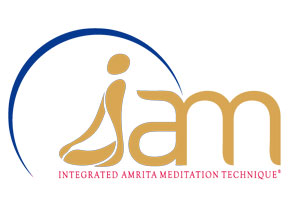Each day you will find the brahmacharis at Amritapuri slowly walking in single file around the perimeter of the bhajan hall. Some have their eyes fixed on the ground, some let malas of rudraksha or rosewood slowly pass through their fingers, others move with their eyes half-closed, clearly focusing on something deep within. All are practicing different forms of walking meditation.
When Amma was a young girl, in order to set an example for others to follow, She would say Her mantra, “Amma’ Amma’ Amma’,” with each step—even going as far as to take a step backward if She ever forgot.
It is also believed that Sri Buddha taught his disciples a form of walking meditation, as in his discourse “Satipatthana Sutta,” he said, “A monk while walking knows “I am walking.’” The walking meditation associated with Lord Buddha involves focusing on the movement of one’s own body to the exclusion of all else, to fully abide in one’s walking.
In essence, both meditations are the same. They are methods of bringing the one-pointedness of meditation into our daily life, methods of cultivating what Amma calls ” bodha” (awareness) and the Buddha called “sati” (mindfulness). After all, we mustn’t limit our spiritual practices to the meditation hall. The point of spiritual life is to come to abide in the sahaja samadhi of Amma —where one perceives God or Brahman pervading everything within and without, eyes opened or closed.
In the beginning it takes a lot of effort to chant the mantra with each step or breath, as Amma did. But if this practice is maintained, eventually the mantra will come on its own accord, without any effort on our part. Amma says the mantra will continue to be chanted, even when we are sleeping. One way to attain this is through associating the mantra with a physical action that we do all the time such as walking or breathing.
Focusing our mind on our physical movements can revolutionise the way we go about our day. Upon practicing this type of meditation many realise a heretofore unnoticed beauty in his or her movements. The experience of walking can become like that of a graceful dance the role of the sole on the ground, the shift in weight from one leg to another. If one concentrates, their entire manner of walking will be transformed perfected, literally from foot to head.
With both of these forms of walking meditation, our thoughts become less and less, and a profound peace ensues. The mind now silenced, we can begin to take in the world through which we are moving with a deep awareness — the trees, the buildings, the clouds, the flowers in the garden, the bees collecting nectar’. We can begin to perceive things about these objects that we’ve never before noticed their uniqueness, their beauty, the mystic perfection with which they’ve been woven and relate to one another. A new world is thus opened up to us. Going even deeper, we can come to experience the underlying unity of all the objects of this creation the pure existence, or ” is-ness,” that is their substratum.
The more awareness we are able to bring to our working day, the deeper our awareness will be when we sit for meditation. This is because we are no longer spending what we’ve worked so hard to earn when we were seated with our eyes closed. In fact, it is just the opposite we are continuing to ” earn” it with eyes open.
We walk all the time. It is something we take for granted. But try “practicing” walking, and see where it leads you.
—Sakshi

